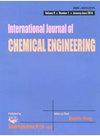清洗介质和温度对中空纤维膜接触器去除水中CO2影响的实验研究
IF 2.4
4区 工程技术
Q3 ENGINEERING, CHEMICAL
引用次数: 0
摘要
通过中空纤维膜接触器(HFMC)的传输现象表明中空纤维内外两相之间的组分交换。在这项研究中,我们设计并制造了实验室制造的HFMC,以评估水和空气作为CO2交换的清扫介质之间的差异。相应地研究了流速和温度比对CO2水溶液吸收的影响。建立了一个包含我们制造的HFMC的半闭合回路,以调节操作参数并使用基于初始pH的方法评估CO2水溶液浓度。我们的实验结果显著表明,当含水CO2浓度高于3.53时,空气往往比水更能去除含水CO2 × 10−6 mlCO2/升。然而,在较低浓度下,水会超过空气。然而,将清扫介质的流速从500增加到1500,增加了两倍 ml/min将该截止点向上移动50次,达到约1.66 × 10−4 mlCO2/升。实验在三种不同的温度比22下进行 : 22,44 : 12和22 : 12°C(富含CO2的液体:吹扫介质)表明,较高的温度梯度会降低吹扫介质的CO2吸收能力。尽管如此,温度梯度在低于1.57的水性CO2浓度下变得非常有效 × 10−6 CO2/l。这项研究的结果可以应用于水性CO2吸收HFMC的性能优化,甚至可以应用于复杂的医疗程序,如动静脉和静脉CO2去除系统,其中水和空气都可以用作血液的CO2清除介质。本文章由计算机程序翻译,如有差异,请以英文原文为准。
The Effect of Sweeping Media and Temperature on Aqueous CO2 Removal Using Hollow Fiber Membrane Contactor (HFMC): An Experimental Determination
Transport phenomena through hollow fiber membrane contactors (HFMCs) indicate the exchange of a component between the two phases, inside and outside of hollow fibers. In this research, we designed and fabricated lab-made HFMCs to assess the difference between water and air as sweeping media for CO2 exchange. The effects of flow rates and temperature ratios on aqueous CO2 absorption were investigated accordingly. A semiclosed circuit incorporating our fabricated HFMCs was set up to regulate the operating parameters and evaluate the aqueous CO2 concentration using an initiative pH-based method. The results of our experiments remarkably reveal that air tends to remove aqueous CO2 more than water when aqueous CO2 concentration is higher than 3.53 × 10−6 mlCO2/l. However, water would surpass air in lower concentrations. Nevertheless, tripling the flow rate of sweeping media from 500 to 1500 ml/min shifts up this cutoff point 50 times to around 1.66 × 10−4 mlCO2/l. The experiments performed at three different temperature ratios of 22 : 22, 44 : 12, and 22 : 12°C (CO2-rich liquid: sweeping medium) demonstrated that a higher temperature gradient deteriorates the CO2 absorption capacity of sweeping media. Nonetheless, temperature gradient becomes highly effective in aqueous CO2 concentrations lower than 1.57 × 10−6 CO2/l. The results of this research could be applied in performance optimization of aqueous CO2 absorbing HFMCs, even in sophisticated medical procedures such as arterio-venous and veno-venous CO2 removal systems where both water and air could be used as blood’s CO2 sweeping media.
求助全文
通过发布文献求助,成功后即可免费获取论文全文。
去求助
来源期刊

International Journal of Chemical Engineering
Chemical Engineering-General Chemical Engineering
CiteScore
4.00
自引率
3.70%
发文量
95
审稿时长
14 weeks
期刊介绍:
International Journal of Chemical Engineering publishes papers on technologies for the production, processing, transportation, and use of chemicals on a large scale. Studies typically relate to processes within chemical and energy industries, especially for production of food, pharmaceuticals, fuels, and chemical feedstocks. Topics of investigation cover plant design and operation, process design and analysis, control and reaction engineering, as well as hazard mitigation and safety measures.
As well as original research, International Journal of Chemical Engineering also publishes focused review articles that examine the state of the art, identify emerging trends, and suggest future directions for developing fields.
 求助内容:
求助内容: 应助结果提醒方式:
应助结果提醒方式:


